
Frequently, falls send older adults to nursing homes. These injuries account for about 40 percent of nursing home admissions. Also frequently, a subsequent fall keeps residents there much longer than they planned. 60 percent of nursing home residents fall every year. As outlined below, these incidents usually cause such serious injuries that the victims can never live independently again.
Many of these victims have pre-exsisting conditions that contribute to their subsequent falls. The previous fall is only the beginning. Other common pre-exsisitng conditions include gair disorders and AMD. People with gait disorders shuffle their feet when they walk. As a result, when they stumble, they usually cannot regain their balance. AMD (Age-related Macular Degeneration) is an eye disorder which affects straight-ahead vision. Such vision is necessary for proper balance. Furthermore, people with AMD might not be able to see some common fall hazards, especially if the room is not brightly lit.
Usually, insurance companies cannot use victims' pre-exsisting conditions against them. It's fundamentally wrong to use another person's weakness to advance your own cause. So, a New York personal injury attorney is usually able to obtain maximum compensation in these matters. This compensation usually includes money for economic losses, such as medical bills, and noneconomic losses, such as pain and suffering.
Fall injury claims, and other injury claims, usually begin with the applicable legal duty. Everyone has a basic legal and ethical responsibility to look out for others, at least to an extent. In premises liability claims, such as falls, the level of duty usually depends on the relationship between the victim and the defendant, who in this case is usually the nursing home owner.
If the victim didn't have permission to be at the nursing home and didn't benefit the owner, the owner usually has no duty. A nursing home guest who refuses to leave when visiting hours ends probably falls into this category.
Usually, judges determine the applicable legal duty during a pretrial hearing. Then, an attorney must prove, by a preponderance of the evidence (more likely than not) that the nursing home breached that duty. Breach usually translated to knowledge of the wet spot, uneven walkway, or other fall-causing hazard.
Direct evidence of actual knowledge could be a restroom cleaning report or an open repair invoice. Attorney usually uncover such direct evidence during a lawsuit's discovery phase. This stage happens relatively late in the process. So, if a nursing home fall claim settles too early, the most compelling evidence might not be available. So, the victim could be settling for less than maximum compensation and not know it.
Circumstantial evidence of constructive knowledge (should have known) is also admissible. This evidence usually follows the time-notice rule, a principle introduced in 1911's Anjou v. Boston Elevated Railway Company.
Ms, Anjou slipped and fell on a banana peel in a busy train station's floor. The court ruled that the owner's knowledge of the hazard depended on the color of the peel, as follows:
As mentioned, the standard of proof is only a preponderance of evidence. So, a little evidence goes a long way in these situations.
Comparative fault and assumption of the risk are two of the most common insurance company defenses in fall injury claims. Both of them harken back to the aforementioned pre-exsisting conditions.
Essentially, comparative fault shifts accident blame from the negligent owner to the victim. Usually, lawyers argue that the victim either didn't watch where s/he was going or fell when another person would have recovered his/her balance and remained upright.
However, if a victim cannot see a hazard, the victim cannot avoid it, no matter how apparent it might be to another person. Furthermore, the fall standard is specific to a particular victim. In other words, if the victim is prone to a fall, the nursing home owner cannot escape responsibility.
Usually, the assumption of the risk defense involves a warning sign, like "Construction Area" or "Caution: Wet Floor." These signs are not get-out-of-jail-free cards. These signs simply make the assumption of the risk defense easier to prove in court. Sign or no sign, the insurance company must prove the victim voluntarily assumed a known risk. If the victim couldn't see the sign, possibly due to AMD, the victim didn't voluntarily assume the risk.
Injury victims are usually entitled to substantial compensation. For a free consultation with an experienced personal injury attorney in New York, contact the Pianko Law Group, PLLC. We do not charge upfront legal fees in these matters.